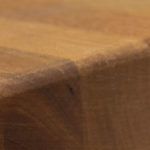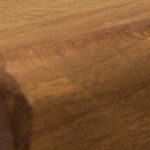The Ultimate Fusion of Nature & Performance
Beautifully Blended Grains & Patterns
The choice of chefs throughout the ages, butcher block combines the very best elements that represent practicality and posh.
Butcher Block surfaces are one of the few features of a home that transcends time and design classification as it is complimentary to rustic, luxury and contemporary stylings. While initially intended for the kitchen, butcher block is now being featured throughout the home wherever style and function are in demand.
Ease of care and enhanced by age, butcher block is designed for the pro, whether your expertise is in making it yourself or making the call for take-out. Bon Appetit!

A Timeless Tradition
There are many options to choose from including species, pattern, edges & finishes.
We are here to help with questions!
Single Species Collection
Butcher Block Tops are available in three patterns. Species will vary with pattern type. Be sure to check out our MIXED SPECIES COLLECTION for additional species/pattern combinations.
Hardness Level 1-9 (9 is hardest) | Uniblock | Gourmet | Ecoblock | |
Knotty Alder | 1 | X | X | |
Yellow Birch | 5 | X | X | |
American Cherry | 2 | X | X | |
Hickory | 8 | X | X | |
Red Oak | 4 | X | X | |
Natural Maple | 7 | X | X | |
Rustic Maple | 2 | X | X | X |
White Oak | 6 | X | X | |
Walnut | 3 | X | X | X |
Thickness | Maximum Width | Maximum Length | |
Uniblock | 1.5" / 2" / 3" | Up to 60" | Up to 144" 3" up to 96" |
Gourmet | 1.5" / 2" / 3" | Up to 40" | Up to 96" |
Ecoblock | 1.5" | Up to 60" | Up to 144" |
Butcher Block Finishes
- Oil Finish ( Standard Finish – No additional charge). Additional periodic applications are required
- Prefinish Clear – Allow additional lead-time
- No Finish (Note: Warranty is Void if no finish is selected)
Specialty Crafted Butcher Block Tops
Butcher Block Tops can be made with one, two or multiple species choose from the following:
- Natural Maple
- Premium Black Walnut
- American Cherry
- Red Oak
- Knotty Alder
- White Oak
- Yellow Birch
- Hickory
Customize further with pattern, edge style, thickness and finish. Some restrictions my apply, contact our customer service team to discuss your ideas.
Butcher Block Care
Because butcher block is naturally porous, it is very important to clean it thoroughly after each use, especially if it is being used for food preparation. A mild soap like liquid dish detergent and water works well. Dry with a towel or other soft cloth. If you prefer, use a bleach and water solution to help kill bacteria. (Mix a tablespoon of bleach with about 1 gallon of water. Keep the solution in a clearly marked bottle out of the reach of children.) You may also be able to remove stains by soaking the area with lemon juice for a few seconds. Never use a scouring pad or cleanser on wood.
Hardwood countertops used as a work surfaces and cutting boards have a *penetrating oil finish. To maintain, periodically apply the oil formulated for kitchen use by following the directions on the bottle. Treatment will be needed if the wood begins to dry out, or lightening in color- especially where pieces are glued together.
Hardwood countertops NOT used for chopping or other food preparation may have been up graded to a maintenance free Urethane coating at the time it was ordered. These surfaces do not need oil treatments. Countertops that are finished with urethane can be washed with mild soap and water, then wiped with a dry cloth. Urethane-finished hardwood is NOT to be used as a cutting surface because knifes will cause permanent damage.
FREQUENTLY ASKED QUESTIONS
Here are some of the common questions that our customers have asked us and may help answer a few of yours.
Feel free to reach out to us if you need any information.
How do I Clean My Butcher Block Counter Top?
If you have your block finished with a varnish, simply wipe as needed with soap/water and a clean cloth. If your butcher block is finished with a food safe natural oil, Scrape off any caked-on dirt and wipe away crumbs. Next, add a few drops of dish soap to a wet sponge, and give the butcher block a good scrub.
Scrubbing along the grain of the wood will make the countertops cleaner. Rinse the sponge, and wipe the counter down with the rinsed sponge. Disinfect. While wood has anti-bacterial properties, you should still disinfect a butcher block countertop.
After you’ve cleaned it off, spray a mixture of white vinegar and water on the surface, spread it around with a damp cloth, let it soak in for a minute or two, and then wipe it off.
How Often Should I Oil My Butcher Block?
To protect both the wood and your health, it’s important to keep butcher blocks sanitized and sealed. We recommend oiling your butcher block at least once a week for the first month. After the first month, if you take the time to clean and oil your butcher block about once a month, you can be assured it will last a lifetime.
It’s equally important that you NOT over-oil butcher block. Over-oiling can cause wood fibers to prematurely break down.
In rare instances, mineral oil will raise the grain of the wood very slightly on new blocks, leaving a patch that’s rough to the touch. This is a natural reaction, NOT a product defect. Roughness can be alleviated easily by lightly sanding the affected area and reapplying oil. Repeat the process as necessary until the block remains smooth.
Keep butcher blocks out of direct sunlight and do not allow water or other liquids to stand.
How Do I Remove Stains?
Sand the butcher block using 150 grit fine sandpaper either with or without a palm sander to create a very smooth kitchen countertop. Once again, only sand in the direction of the grain and clean the surface with a tack cloth to remove the sanding dust. Once the stain has been sanded out, re-oil with a food safe mineral oil to restore and protect the grain of the wood.
Depending on the severity of the stain/s and if it needs to be restored, you can also stir a teaspoon of powdered oxygen bleach (sodium percarbonate) into a cup of hot water until it dissolves. Wearing a nitrile glove, dip a stiff, nylon-bristle scrub brush into the solution and scrub the wood for a couple of minutes. Re-dip as needed to keep the surface wet. The mix will foam slightly, then subside.
Can You Create Something Custom For Me?
If you have a special project that doesn’t fit the exact products we have listed, feel free to contact us and we can help determine the best way to get your important project figured out.

















